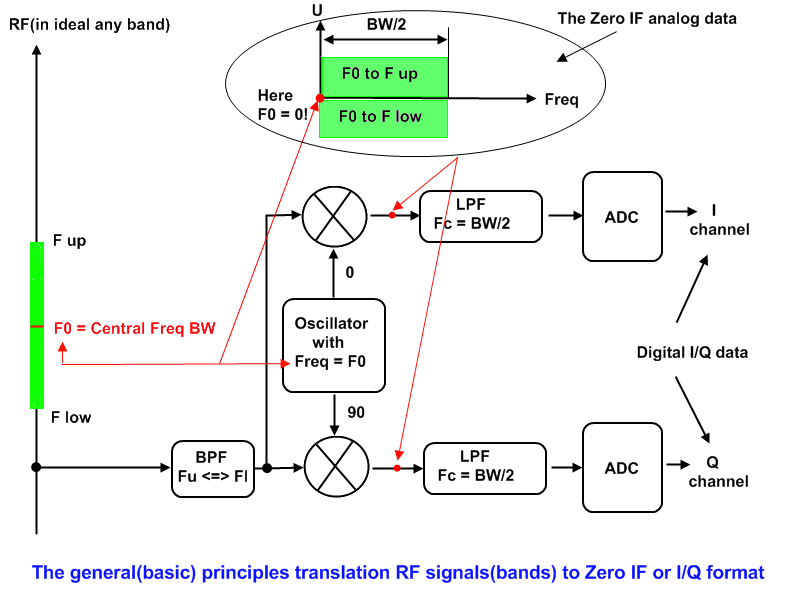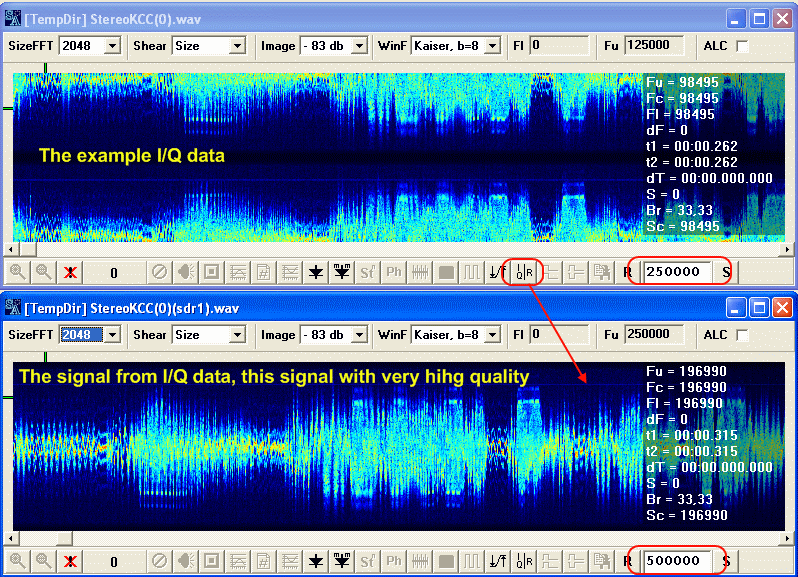|
|
| Разместил (Author): |
SergUA6  |
| Авторские права |
© http://www.radioscanner.ru |
|
|
Текст
|
I/Q format records. SA and I/Q records.
We have received some letters, concerning I/Q format and usage of I/Q records in SA.
Let's try understand, what is I/Q record, why is it good and what possibilities it represents for the analysis and signal’s identification.
Why is I/Q format good and what possibilities it represents?
Standardly, 90-80 % of usual receivers, produce, as result of their operation, an audiostream. It is the real signal, which is standardly written in wav file, and after that, it can be used for analysis and identification, or placed somewhere on the Internet. Quality of such signal is completely depends on receiver’s characteristics.
The receiver in this case, is fully realizing processing of the signal, and in most cases, receiver "solves" for you, what and how to do with the signal. Of course, it is supposed, that the receiver is managed/controlled/used by competent user, however, practice shows that it is far not so. High enough number of people, still, do not suppose, what is going on inside of receiver, and what is going on at the recording process. That is why Internet is full of records with the very low quality, or even "non-liquid" for analysis/identification record. In most of such records, we do not have the real signal, but something which is only a bit similar to it, or even not similar at all, in very bad cases. The main problem, is that, far not each user wants to gain an understanding of the very big diversity of various classes of signals and special sorts of modulations/manipulations.
Luckily, today, old enough and known ideas, thanks to existing computer technologies and its power, are successfully realized in the form of SDR technologies. What is SDR technology? SDR technology means, linear qualitative transfer of required segment of a spectrum, into area of low frequencies, and its further processing.
All charm of this technology, is that for this technology it doesn't matter what sort of modulation in the signal, and what are features of the signal, how high the skill of concrete user - the signal will be transferred on relatively low frequencies without distortions, in it's initial form. After that, the signal can be saved for the detailed analysis.
Please, pay attention, that we are speaking not about the signal after demodulation and processing, as it becomes in usual receivers, but about the signal in that sort as it is. In what sort the signal is represented in this case? It is I/Q format. Sense and method of I/Q format forming is represented below:

The signal(necessary range):
1 is selected, if it is necessary, by the entry bandpass filter
2 and it is transferred on zero IF in the form of two quadrature channels I and Q
3 then each channel is filtered by LPF filter and moved on ADC.
As a result of such transferring, in each channel, there is a folded up/convoluted half-and-half spectrum of the main signal and phase shift between channels is equal exactly 90 degrees.
(Let's not go deep into Mathematics, all this is well described in the theory).
Such approach allows:
in the first, to reduce sampling rate in each channel, at the expense of spectrum's convolution
in the second, to develop the signal into "complete growth" at any time, in that sort, in which it was, when it is necessary, at the expense of phase shift in 90 degrees between channels.
If digit capacity of ADC is selected correctly, and own level of noise of conversions is small, then having saved channels I and Q in the record form, we are getting an absolutely exact initial signal, without any distortions.
Standardly, for these purposes the stereo format of wav files is used. In one of channels samples
I are written, and in another one samples Q, or on the contrary, it does not play a special role.
Thus, the record of format I/Q is the standard stereo file, which demands special processing further.
How to work with I/Q records in SA? Easy!
SA it positioned as software for the qualitative analysis (signals correct identification), and, of course, I/Q format takes a special place in SA, because I/Q format is potentially guarantying an absolute quality of initial material.
That is why, there is special mechanism in SA, which allows to receive the real, present signal from I/Q record, for the further operation with this signal.
So how it looks on practice? It is very simple. At loading of standard I/Q record, SA is warning you, that the record is the stereo record, and SA suggests:
to select the channel
to load all samples

You need only select the point "load all samples", and converting of I/Q record into the real signal will begun.

That's it! Now, it is possible to work with the signal in complete volume of SA possibilities. You can save the file, filter it, re-sample, demodulate it and etc etc etc.
It is noticeable that the sampling rate of the file with the real signal is twice more than initial I/Q, and it is normal. Because now the signal is presented completely as the real one, and instead of two channels as earlier, we got one. However, data volume is remained precisely same: data is not reduced or increased in the file with real signal, the data in such file is simply represented in other sort, which is more convenient for human.
Why some people are still deny I/Q format, while it is obvious that I/Q is the most suitable for analysis and identification?
It is obvious that format of I/Q records is the most preferable for analysis, and it seems like it is clear enough. However, on practice, we often meet complete not understanding of this fact.
And there are some reasons for it. Let's consider them:
The first and the main reason, is that, almost all owners of SDR receivers, are confident, that various demodulators, which are included in software, which is supplied with these receivers are miracle.
Please do not get under self-deception, everything is not so is easy, and mostly, everything is not easy at all.
Necessity to work in real-time, orientation on radio signals listening, and many other factors force to use solutions, which are far from the ideal. In result, after demodulation, such records become nothing better, and sometimes even worse than, the records, which are done by usual receivers.
SDR receiver, which does not allow to write necessary bar or a signal in I/Q form, is lame by default
If you want to correctly identify any signal, first of all, You should be interested it the signal’s initial form only. And such form can be provided only in pure I/Q format.
Some people, who already faced with I/Q files in SA, have noticed that, sometimes, level of I/Q record is very low.
It is not the problem of SA. It is the problem of SDR receivers and their circuitry.
Maximum, what it is possible recommend in such situations, is to try to increase amplitude of a signal as soon as possible, before any manipulations with the file.
For example, after loading I/Q record, we can, at once, estimate and increase signal level if it is necessary:

Then it is necessary to save the file as usual wav, and after it is loaded again to process it as I/Q. It can compensate weak level of initial file in some measure.
Although it will not completely solve this problem, I underline, this is not SA problem, and this problem should be solved on the stage of the record's forming, because these are questions of SDR equipment competence.
The second reason why some people still do not consider I/Q as the most suitable for analysis format is that: there is an opinion that I/Q record is too plentiful and takes unfairly big volume. It not so truly.
I/Q assumes, that signal is transferred on zero frequency and if, to write only the signal with a reasonable store, then the volume/size of the record will be exactly such as necessary, no more and not less.
Another matter, if the signal has a bar in 10 kHz, but whole segment of range of the signal radiation (for example 1Mhrz) is fully transformed in I/Q, then of course, in this case, we have an absolutely redundant record. This kind of records says only, that the user who have done this record, simply do not understand he was doing.
Do not compare size of records of the signal after demodulation and the size I/Q record of a complete signal before demodulation.
In the first case, You work only with image of signal, and You do not know how was this image gotten, and if this image is even correct. In the second case, You work really with the present signal, and only You solve when and how should it be demodulated.
Surely, in the second case, the chances of correct identification of the signal are incommensurably higher then in the first case.
It is very strange to hear that I/Q has too big unjustified volume from the people, who are making demodulated signals with bar in 3 KHz, in wav files with sampling rate 44100 Hz, in stereo format, and after that these people contrived to compress it by mp3 codec!
After all they are sincerely surprised that nobody have any interest in their records.:)
Good Luck~
|
|
|
|
Добавлять комментарии могут только зарегистрированные, активировавшие регистрацию и не ограниченные в доступе участники сайта!
|
| Файл создан: 21 Nov 2009 21:23, посл. исправление: 21 Nov 2009 21:36 |
|

